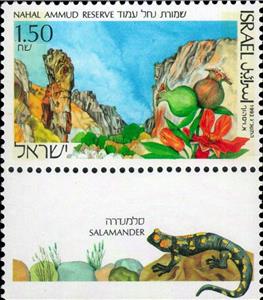Stamp: Nahal Ammud Reserve; on Tab: Common Fire Salamander (Salaman (Israel 1993)
Nahal Ammud Reserve; on Tab: Common Fire Salamander (Salaman (Israel 1993)
16 February (Israel ) within release Nature Reserves goes into circulation Stamp Nahal Ammud Reserve; on Tab: Common Fire Salamander (Salaman face value 1.50 Israeli new shekel
| Stamp Nahal Ammud Reserve; on Tab: Common Fire Salamander (Salaman in catalogues | |
|---|---|
| Michel: | Mi:IL 1253 |
| Israel Philatelic Federation: | Isr:IL 1259 |
Stamp is square format.
Also in the issue Nature Reserves:
- Stamp - Hof Dor Reserve; on Tab: Sanderling (Calidris alba) face value 1.20;
- Stamp - Nahal Ammud Reserve; on Tab: Common Fire Salamander (Salaman face value 1.50;
- Stamp - Nahal Ayun Reserve; on Tab: Indian Crested Porcupine (Hystri face value 1.70;
- First Day Cover - Nature Reserves in Israel (FDC) face value 4.40;
Stamp Nahal Ammud Reserve; on Tab: Common Fire Salamander (Salaman it reflects the thematic directions:
A landscape is the visible features of an area of land, its landforms and how they integrate with natural or man-made features. A landscape includes the physical elements of geophysically defined landforms such as (ice-capped) mountains, hills, water bodies such as rivers, lakes, ponds and the sea, living elements of land cover including indigenous vegetation, human elements including different forms of land use, buildings and structures, and transitory elements such as lighting and weather conditions. Combining both their physical origins and the cultural overlay of human presence, often created over millennia, landscapes reflect a living synthesis of people and place that is vital to local and national identity. The character of a landscape helps define the self-image of the people who inhabit it and a sense of place that differentiates one region from other regions. It is the dynamic backdrop to people’s lives. Landscape can be as varied as farmland, a landscape park, or wilderness. The earth has a vast range of landscapes, including the icy landscapes of polar regions, mountainous landscapes, vast arid desert landscapes, islands and coastal landscapes, densely forested or wooded landscapes including past boreal forests and tropical rainforests, and agricultural landscapes of temperate and tropical regions.
Flora is the plant life occurring in a particular region or time, generally the naturally occurring or indigenous—native plant life. The corresponding term for animal life is fauna. Flora, fauna and other forms of life such as fungi are collectively referred to as biota. Sometimes bacteria and fungi are also referred to as flora, as in the terms gut flora or skin flora.
In geology, rock (or stone) is any naturally occurring solid mass or aggregate of minerals or mineraloid matter. It is categorized by the minerals included, its chemical composition, and the way in which it is formed. Rocks form the Earth's outer solid layer, the crust, and most of its interior, except for the liquid outer core and pockets of magma in the asthenosphere. The study of rocks involves multiple subdisciplines of geology, including petrology and mineralogy. It may be limited to rocks found on Earth, or it may include planetary geology that studies the rocks of other celestial objects.



